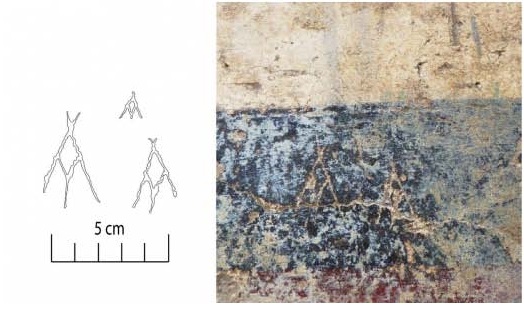
CIMRM Supplement - Mithraeum of the coloured marbles. Ostia, Italy.

Graffiti
Other items
A Mithraeum of the late 4th century was discovered in Ostia in 2014, in the area outside the Porta Marina (=sea gate), in a converted caupona (IV, ix, 5). The cult chamber has a single bench, a well, and what was possibly a small flower-bed. An adjacent room contains two graffiti, one of which mentions Mithras and Kronos. The building was only used for a short time.
Details
In the early third century a two-storey caupona (tavern/eating-place) was built on the street known today as the via della Marciana, opposite the baths. The central room has a mosaic of pan, so the building is known as the "caupona of the god pan".
In the second half of the 4th century, the building was repurposed, the main entrance closed, and the walls repainted with imitatation marble.
Room 1 : The spelaeum
From David, "Il Pavimento":
Along the northern flank of the caupona there was initially a basement environment (7.20 mx 3), which was completely restored by raising the floor by 70 cm and creating a ritual well with real marmorea5 and a special corner space (probably used as a flowerbed) . The interior was fitted with a low counter (4 x 1.35 m), raised about 20 cm above the floor, to support a long banquet table. At the bottom of the apse is a niche that was to house a furnishing element (perhaps a cathedra or a throne for the pater); on the back wall there is a molded frame in white marble that was to serve as a support shelf for a carved slab (unfortunately lost) which is clearly the traditional Mithraic icon with the sacrifice of the bull.
From M. David, "A newly discovered Mithraeum at Ostia", 2018:
In the apse of the spelaeum, there was a rectangular niche, and in the nave two altars, a single podium, a small bed of flowers, and a ritual well in marble. The furniture, perhaps in wood, was mobile (fig. 10). It is utterly a space totally different in regard to mithraea known up to this time at Ostia, which in their turn are representative of the complexity and of the variety of Mithraist architectural experiences in the Roman world. The difference is linked principally to the very limited space, to the presence of a single bench and to the particularities of the pavement, comparable with those known from the 5th century (in Sicily, for example).
The room is decorated with a floor made up of marble fragments, a form of decoration popular in the 4-5th centuries. The small bed of flowers proved to contain traces of juniper.
Room 3: The graffiti and monograms
On the west wall of room 3, the main chamber of the old caupona with the pan mosaic, there are two graffiti.
The first is just a name, "Concordius". This name is wide-spread starting from the 4th century, mostly in Christian epigraphy. At this period the old Roman custom of three names had largely been abandoned in favour of a single name.
Beneath this is another graffiti:
Inv(icto) D(eo) (arrow) M(ithrae) (bow with an arrow) D(eo) M(agno) Kro/no
To the unconquered god Mithras and to the great god Kronos".
On the south wall some monograms with Mithraic characteristics were found.
A graffito of the navigium of Isis was also found. Also found in the room was an ivory handle, perhaps from a sistrum, an item of Egyptian origin but also appearing in the mosaic in the Mithraeum of Felicissimus as associated with the grade of Leo.
Room 8 : The trident paintings
In one of the secondary rooms (no. 8), decorative elements of symbolic worth and of great interest have been identified; on the pedestal, painted in red on deep yellow, a “trident”, alternating with arrows, is repeated several times (fig. 8).
Bibliography
- M. David, "First Remarks about the Newly Discovered Mithraeum of Colored Marbles at Ancient Ostia", Mediterraneo antico 20 (2017) 171-182. Online here.
- M. David &c, "Il pavimento del nuovo Mitreo dei marmi colorati a Ostia antica", in: AISCOM (2016) 369-376. Online here.
- Massimiliano David, "A newly discovered Mithraeum at Ostia", Acta Antiqua Academiae Scientiarum Hungaricae 58 (2019), p.117-131. Online here.
| Tweet |









